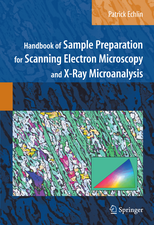Scanning Electron Microscopy and X-Ray Microanalysis: A Text for Biologists, Materials Scientists, and Geologists
Autor Joseph Goldstein, Dale E. Newbury, Patrick Echlin, David C. Joy, Charles Fiori, Eric Lifshinen Limba Engleză Paperback – 20 mar 2013
Preț: 659.70 lei
Preț vechi: 776.13 lei
-15% Nou
Puncte Express: 990
Preț estimativ în valută:
126.23€ • 131.80$ • 104.47£
126.23€ • 131.80$ • 104.47£
Carte tipărită la comandă
Livrare economică 05-19 aprilie
Preluare comenzi: 021 569.72.76
Specificații
ISBN-13: 9781461332756
ISBN-10: 1461332753
Pagini: 692
Ilustrații: XIII, 673 p. 322 illus.
Dimensiuni: 155 x 235 x 40 mm
Greutate: 0.95 kg
Ediția:1981
Editura: Springer Us
Colecția Springer
Locul publicării:New York, NY, United States
ISBN-10: 1461332753
Pagini: 692
Ilustrații: XIII, 673 p. 322 illus.
Dimensiuni: 155 x 235 x 40 mm
Greutate: 0.95 kg
Ediția:1981
Editura: Springer Us
Colecția Springer
Locul publicării:New York, NY, United States
Public țintă
ResearchCuprins
1. Introduction.- 1.1. Evolution of the Scanning Electron Microscope.- 1.2. Evolution of the Electron Probe Microanalyzer.- 1.3. Outline of This Book.- 2. Electron Optics.- 2.1. Electron Guns.- 2.2. Electron Lenses.- 2.3. Electron Probe Diameter, dp, vs. Electron Probe Current i.- 3. Electron-Beam-Specimen Interactions.- 3.1. Introduction.- 3.2. Scattering.- 3.3. Interaction Volume.- 3.4. Backscattered Electrons.- 3.5. Signals from Inelastic Scattering.- 3.6. Summary.- 4. Image Formation in the Scanning Electron Microscope.- 4.1. Introduction.- 4.2. The Basic SEM Imaging Process.- 4.3. Stereomicroscopy.- 4.4. Detectors.- 4.5. The Roles of Specimen and Detector in Contrast Formation.- 4.6. Image Quality.- 4.7. Signal Processing for the Display of Contrast Information.- 5. X-Ray Spectral Measurement: WDS and EDS.- 5.1. Introduction.- 5.2. Wavelength-Dispersive Spectrometer.- 5.3. Energy-Dispersive X-Ray Spectrometer.- 5.4. Comparison of Wavelength-Dispersive Spectrometers with Energy-Dispersive Spectrometers.- Appendix: Initial Detector Setup and Testing.- 6. Qualitative X-Ray Analysis.- 6.1. Introduction.- 6.2. EDS Qualitative Analysis.- 6.3. WDS Qualitative Analysis.- 6.4. X-Ray Scanning.- 7. Quantitative X-Ray Microanalysis.- 7.1. Introduction.- 7.2. ZAF Technique.- 7.3. The Empirical Method.- 7.4. Quantitative Analysis with Nonnormal Electron Beam Incidence.- 7.5. Analysis of Particles and Rough Surfaces.- 7.6. Analysis of Thin Films and Foils.- 7.7. Quantitative Analysis of Biological Material.- Appendix A: Continuum Method.- Appendix B: Worked Examples of Quantitative Analysis of Biological Material.- Notation.- 8. Practical Techniques of X-Ray Analysis.- 8.1. General Considerations of Data Handling.- 8.2. Background Shape.- 8.3. Peak Overlap.- 8.4. Dead-Time Correction.- 8.5. Example of Quantitative Analysis.- 8.6. Precision and Sensitivity in X-Ray Analysis.- 8.7. Light Element Analysis.- 9. Materials Specimen Preparation for SEM and X-Ray Microanalysis.- 9.1. Metals and Ceramics.- 9.2. Particles and Fibers.- 9.3. Hydrous Materials.- 10. Coating Techniques for SEM and Microanalysis.- 10.1. Introduction.- 10.2. Thermal Evaporation.- 10.3. Sputter Coating.- 10.4. Specialized Coating Methods.- 10.5. Determination of Coating Thickness.- 11. Preparation of Biological Samples for Scanning Electron Microscopy.- 11.1. Introduction.- 11.2. Compromising the Microscope.- 11.3. Compromising the Specimen.- 12. Preparation of Biological Samples for X-Ray Microanalysis.- 12.1. Introduction.- 12.2. Ambient Temperature Preparative Procedures.- 12.3. Low-Temperature Preparative Procedures.- 12.4. Microincineration.- 13. Applications of the SEM and EPMA to Solid Samples and Biological Materials.- 13.1. Study of Aluminum-Iron Electrical Junctions.- 13.2. Study of Deformation in Situ in the Scanning Electron Microscope.- 13.3. Analysis of Phases in Raney Nickel Alloy.- 13.4. Quantitative Analysis of a New Mineral, Sinoite.- 13.5. Determination of the Equilibrium Phase Diagram for the Fe-Ni-C System.- 13.6. Study of Lunar Metal Particle 63344,1.- 13.7. Observation of Soft Plant Tissue with a High Water Content.- 13.8. Study of Multicellular Soft Plant Tissue with High Water Content.- 13.9. Examination of Single-Celled, Soft Animal Tissue with High Water Content.- 13.10. Observation of Hard Plant Tissue with a Low Water Content.- 13.11. Study of Single-Celled Plant Tissue with a Hard Outer Covering and Relatively Low Internal Water Content.- 13.12. Examination of Medium Soft Animal Tissue with a High Water Content.- 13.13. Study of Single-Celled Animal Tissue of High Water Content.- 14. Data Base.- Table 14.1. Atomic Number, Atomic Weight, and Density of Metals.- Table 14.2. Common Oxides of the Elements.- Table 14.3. Mass Absorption Coefficients for K? Lines.- Table 14.4. Mass Absorption Coefficients for L? Lines.- Table 14.5. Selected Mass Absorption Coefficients.- Table 14.6. K Series X-Ray Wavelengths and Energies.- Table 14.7. L Series X-Ray Wavelengths and Energies.- Table 14.8. M Series X-Ray Wavelengths and Energies.- Table 14.9. Fitting Parameters for Duncumb-Reed Backscattering Correction Factor R.- Table 14.10. J Values and Fluorescent Yield, ?, Values.- Table 14.11. Important Properties of Selected Coating Elements.- References.
















